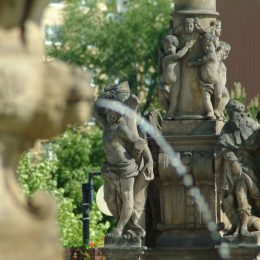Elegance and beauty of ancient world in Most..
Four allegories are real-life sized. They were made from a mild grounded sanddtone. Thanks to the signature on one of them we can tell that they are from a sculpture shop of Jan Brokoff. It was probably his older son Michal Jan Josef who made them. As for year of their establishment we assume that it was 1715. But the reason why is really interesting. Locals probably purchased them as a protective symbol against the elements. This fact is quite reasonable, because in the past there were a lot of these curiosities happening – mostly fires.
Monument of the old town Most
The original placement of the allegory was at the town hall of our old city. To be exact, back then, you could find them at the edge of the renesance building. But when the town hall was demolished in 80’s of 19th century the allegory was moved to the belltower of the Church of the Assumption of the Virgin Mary. Visitors could see them at the second floor. After that it was supposed to be moved again. But plans had changed so the allegory was resting in local museum for many years. After the demolition of old city, to by exact in 1979, all of the four allegories were put on a pedestal in front of the town hall in the newly built city. And you can find them there till today.
Allegory of the Four Elements – appearance
In total there are four sculptures. Each of them exterioze one of the four elements – earth, air, water and fire. If you are reaching to see them from our 1st squre you will approach them in this exact order. The allegory of earth is a goddes of the fruitability of earth and harvest. It is also known as a gifter of grain called in Rome as Ceres and in Greece as Démétér. The next one is the allegory of air. This one is also symbolized as woman. She is standing on the clouds and her long hair are flying in the air. Also on her side there is an eagle. The allegory of water is a god of seas Neptun or Poseidón in Greece. He has beard and a crown on his head and is partly standing on a big fish creature. The last of them is the allegory of fire. This one is the most dramtic one. It is a man standing on a stack of a burning wood and his head is turned the other way from it.
Some parts of the sculptures has been moderately distroyed so now they are modeled from a fake sandstone during the restoration process.












